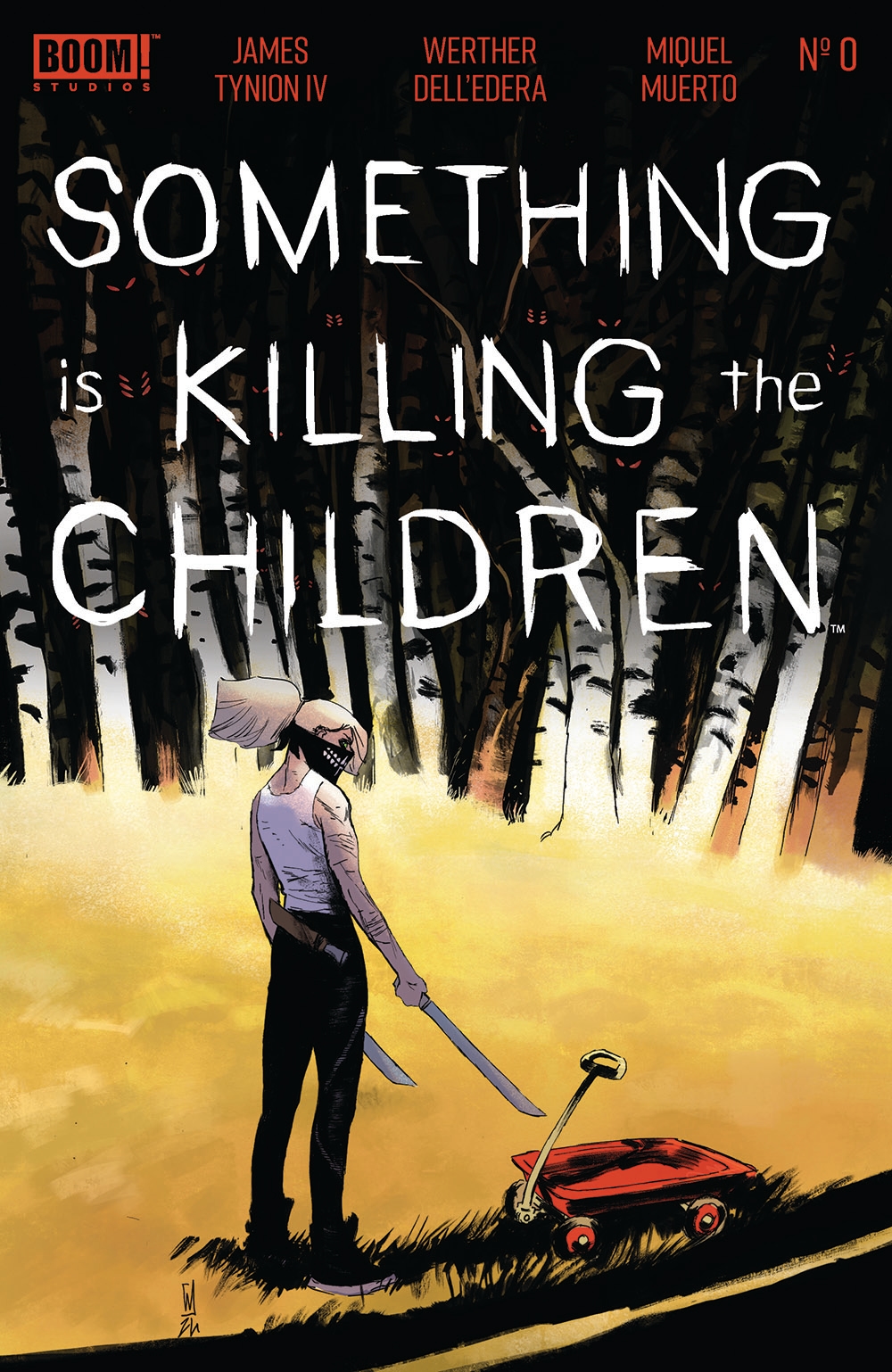How James Tynion IV Launched the Biggest Horror Comic Title In the Business

It’s Halloween and the highest-selling comics author of the decade, including the biggest horror title in the business, is going to stay in his Brooklyn apartment and watch some movies.
Oh, sure, there may be some friends over, but James Tynion IV is trying to keep it low-key, with 1980s flicks The Monster Squad, Return of the Living Dead, and Re-Animator on the home marquee. The author is still recovering from New York Comic-Con, where he and his eight-person company, Tiny Onion, which is backed by Lyrical Media, had a major presence. He is the rare comic author that has books across all the major publishers save Marvel, almost all creator-owned. There’s also a Substack newsletter. And a fledgling media division that seeks to catapult those books into various mediums.
Tynion made his name writing Batman for DC, striking out on his own while the proverbial iron was hot. He has had plenty of hits to his name, Image Comics’ Department of Truth or DC’s The Nice House on the Lake, but the comic that stands above all is Something Is Killing the Children, which he created with artist Werner Dell’Edera.
Launched in 2019 and originally intended to be only a five-issue mini-series, SIKTC rather quickly grew into an industry sensation, becoming the biggest independent comic book and franchise since 2012’s Bryan K Vaughan sci-fi fantasy Saga and arguably since The Walking Dead, Robert Kirkman’s zombie opus that debuted in 2013.
It certainly is the highest-selling comic that Boom! Studios has ever published, with over 5 million copies sold worldwide. There is even a spin-off series titled House of Slaughter, whose debut issue sold over 500,000 when it was first published in October of 2021, making it the 2nd highest-selling non-Marvel or DC first issue launch of the 21st century, beaten only by Boom!’s Keanu Reeves’ action mini-series BRZRKR No. 1.
Readers quickly became captivated by the mysterious story of Erica Slaughter, a hunter of monsters that only kids and teens can see. She wears a fearsome toothy bandana as a mask, as do her cohorts at the equally mysterious organization she is forever tied to, the Order of St. George. It wasn’t just readers. The comic industry noticed as well, and Tynion won the Eisner Award for best writer in 2021, 2022, and 2023, becoming the first writer since Alan Moore and Neil Gaiman to win the that category three years in a row.
SIKTC sells upwards of 50,000 copies a month, with Slaughter selling around 25,000, according to sources, making the franchise the highest-selling creator-owned title out there, and besting a majority of comics put out by DC and Marvel. When Penguin Random House bought Boom! earlier this year, SIKTC was a factor in the acquisition. And Netflix, meanwhile, is in the middle of developing a series adaptation, with Baran bo Odar and Jantje Friese, the German creators of buzzy cult series Dark and 1899, writing and potentially showrunning.
Now, in celebration of the comic’s fifth anniversary, Tynion and Boom! are in November putting out Something Is Killing the Children No. 0, set before the events of the first issue that serves both as an introduction to new readers and sets the table for what’s to come.
Tynion spoke with The Hollywood Reporter to mark the anniversary, talking about that really long title, his debt of gratitude to Walking Dead author Kirkman, and how long the comic can keep stabbing its stories. “Yes, I have an ending in mind,” Tynion says. But fear not. That ending is likely years away.
Let’s start with what we as readers first see when we pick up the comic. The title. It’s long. And it’s now kicked off a trend of comics with super long titles. How did the title come into view for you?
It’s actually a title that I first used for a short story I wrote while I was in college. It had nothing to do with the final product and it wasn’t a good short story, but I loved the title. I knew there was a special kind of energy to it, and it was something that over the years I kept rolling up different concepts, bringing them towards the title and sort of seeing whether or not it finally found a story worthy of it. And ultimately the comic that would become Something is Killing the Children is what I pitched Boom Studios.
It’s the sort of title you see a lot more often in a novel than you do on a comic shelf. But part of the reason is it goes back to the old newsstand days where the ways that comics were shelved, you needed to be able to see the title above the fold if magazines were stacked in front of each other. But that’s not really how a lot of comic shops actually shelved their books these days.
I really do attribute a lot of the success of the book to people who bump into that title and they want to know what’s killing the children.
Now, this was supposed to be a five issue miniseries. At what point did the plans change and why?
When I pitched the story, I sort of saw it as five standalone adventures of this character, Erica Slaughter. And she would kind of be in the background. We would see a small town and this mysterious figure would come through the small town and only the children would understand that this is the person actually arriving to take down the monsters. It would be all of these different flavors and these different sorts of characters. But it was while I was writing the first issue that then I realized it’s like I don’t want to try to close this entire story out in a single 24-page comic book. And so I reached out to my editor Eric Harburne, and I was just like, I need all five issues to tell this one story.
And then by the time I got to the start of issue three, I was just like, “Hey, I can’t finish this in five issues. I need 15 to tell the story that I want to tell with all these characters and matching the tone and all of that.”
The comic was also a change from your usual writing style. How so?
At the time I was writing a lot of superhero comics and specifically I was writing a lot of superhero comics that had a kind of science fiction or magical edge to them. And there was something so refreshing to the world if Something is Killing the Children, which did have these supernatural qualities to it, but it was a very grounded world.
I remember it being incredibly refreshing in writing the first few. I think it’s the second issue has a scene that takes place in an Applebee’s. And I didn’t have to explain the structure of the multiverse in exposition to make a reader understand that we were in an Applebee’s. I just had to put them in an Applebee’s.
It untapped a type of writing in me that I didn’t set out to do. The book really kind of taught me how to write it.
How far do you think you can take this story?
I have an outline that takes me past issue 100, and we are currently on issue 41 right now. We’re five years in, so there’s at least another five years of this and probably more. Boom Studios was recently acquired by Random House Worlds, and I was talking to one of the heads over there and I said, “I want to get to issue 100.” And he said in response, “What about 200?” We have a big story that we’re setting out to tell and yeah, we’re just getting started.
Do you know where this thing is going to end?
Yes, I have an ending in mind. I know the conclusion that we’ve been heading towards from the start of issue one of Something is Killing the Children. And I think there are lots of little side roads we can go down before then and those can kind of accordion out or accordion down, but the story of Erica Slaughter does have an end point.
Is there a value in doing an ongoing series that a mini-series doesn’t have?
I’m sitting in front of a wall of comic book trades and my favorite series were always the ones that ran for volumes and volumes and volumes that I was able to follow those characters stories over the course of years. And I think the most successful comics of all time, particularly in the corner of comics in which I work, have always been those long form stories and those big runs. And that’s really what we’re trying to go after with Something is Killing the Children.
The reason I ask that question is I think we live in a time of less ongoing series and lots of mini-series, and if there’s an ongoing series that is launched, by issue 10, it’s canceled and a few months later it’s relaunched again. So that seems to be a modern publishing problem.
I do think it can be shortsighted because the thing that Something is Killing the Children proves to me is that in the modern day and age, a series can build an audience over time. I think a lot of times now everything is positioned around the launch of a big number one. When Something is Killing the Children launched, it launched very, very strongly for the market. At that time, I think we were around 40,000 copies, but once we got into the teen issues, the series had multiple issues that were breaking six figures. It is rare that a series can double its monthly audience and beat it a little bit into the series. Now we have a very healthy monthly audience for the series. I do believe that if you’re building a really, really rich world and you trust that it can find an audience that there is an audience to find.
The other unique aspect to the comic is that in a time where one artist can’t stay on a book for more than four or issues before bailing, Werther has stayed with it since the beginning. Which is another factor in its success. People want continuity in the books they read.
As the creators of the series me and Werther we’re not going to let anyone else write the right or draw the story of Erica Slaughter. We’ve had a lot of success with our spinoff series, House of Slaughter, but that expands the world that Erica lives in. But if you are a fan of Erica Slaughter, you will get her entire story from start to finish in the pages of Something’s Killing the Children. And I will write all of it and Werther will draw all of it. There’s no compromising on that.
Why do you think it took off the way it did?
I will always be eternally grateful for Robert Kirkman’s surprise ending The Walking Dead. He was continuing to solicit more issues past what was the actual final issue, but then an oversized issue showed up in comic shops and it was the last issue of the series. And suddenly there were all of these readers looking for a horror book and there was no new horror books coming out in comics at that time. And Something is Killing the Children was the next orderable number one that was coming out. There was no way to capitalize that or plan for it, but it meant that I think a lot of shops gave us a chance because they were looking for someone for a series that they could pass that audience onto on too. Thank you, Robert.
The book has unique sense of pacing…
I’ve done a lot of time in superhero comics but I came of age in the manga boom of the early two thousands. Something is Killing the Children is really the first time I was able to lean in to that kind of manga storytelling. It’s a slower, more character driven pacing. It’s a slightly more decompressed. You linger in the character moments. You’re not trying to rush to the next action scene. That is part of what I think gives Something is Killing the Children its page-turner quality.
But the single most important thing that sells this book is the character of Erica Slaughter. The visual of her, which I attribute entirely to Werther … he designed this incredible bandana for the character as a throwaway concept when he was first doing the character designs. And with it, he sent a note about how in order to fight the monsters, she becomes the monster. And then once he wrote that and I saw her in that look, just like that I understood the character and I understood what book I was writing.
How do you and Werther work together? How complete are your scripts?
There are a few issues that especially if something’s more action driven, sometimes I’ll do the classic Marvel Method, the plot style, and just sort of lay out the kind of key visual beats and all that. And then I’ll go back over, do the dialogue after all of the art is complete. Then other issues are very dialogue heavy so I will write out the full flow of dialogue and I’ll have very, very loose panel descriptions throughout. But really the average script that I do is kind of a blend between them.
Now you are about to do an issue zero. It’s very nineties of you.
(Laughs) We wanted to do something to celebrate the fifth anniversary of the series, and we’re at an interesting place in the story of Erica Slaughter. And there were a few more things that needed to happen in the background in setting up the next arc of the book. In Something Is Killing the Children No. 1, we see Erica Slaughter emerge from the end of a case, and that is right before she goes into Archer’s Peak, which kicks off the entire main series. And we wanted to go back and recontextualize what happened in that first case and show it in the context of the larger world mythology that we’re building around it.
So it’s one of those things where it functions really well as a standalone, that introduces you to the world and who Erica Slaughter is and what she stands for on what some of her core emotional damages. But then it starts laying out some seeds of the threats that she will face in the years to come.
Cover of issue 0 of Something Is Killing the Children Courtesy of Boom! Studios
Source: Hollywoodreporter
Related Posts
- Roundball Rocked: With NBA Return Looming, NBC Purges Scripted Roster
- SoundCloud Says It “Has Never Used Artist Content to Train AI Models” After Backlash on Terms of Service Change
- Fox News’ Camryn Kinsey Is “Doing Well” After Fainting on Live TV
- Kerry Washington and Jahleel Kamera in 'Shadow Force.'
Courtesy of Lionsgate
…
- This Alternative Artist Landed a Top-20 Chart Debut With an Album Made Almost Entirely on His Phone





